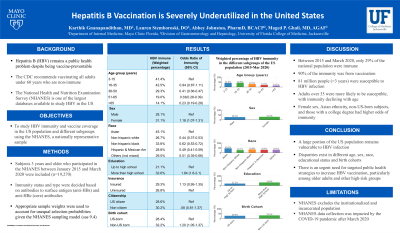Sunday Poster Session
Category: Liver
P1151 - Hepatitis B Vaccination is Severely Underutilized in the United States
Sunday, October 27, 2024
3:30 PM - 7:00 PM ET
Location: Exhibit Hall E

Has Audio

Karthik Gnanapandithan, MD, MS
Mayo Clinic
Jacksonville, FL
Presenting Author(s)
Award: Presidential Poster Award
Karthik Gnanapandithan, MD, MS1, Lauren N.. Stemboroski, DO2, Maged A.. Ghali, MD2
1Mayo Clinic, Jacksonville, FL; 2University of Florida College of Medicine, Jacksonville, FL
Introduction: Hepatitis B virus (HBV) remains a public health problem despite being vaccine preventable. CDC estimated 13,300 incident HBV infections in the US in 2021. The number of acute HBV cases among adults over 40 has increased. The CDC now recommends vaccinating all individuals aged 19–59. The National Health and Nutrition Examination Survey (NHANES) is one of the largest databases available to study HBV in the US population. Using this nationally representative sample, we looked at the prevalence of HBV immunity and vaccine coverage in the US population and different subgroups.
Methods: The study included subjects 3 years and older who participated in the NHANES between 2015 and March 2020. Those with positive anti-HBs antibodies were considered immune to HBV infection. Among those immune, the presence or absence of anti-HBc was used to differentiate immunity from infection and vaccination. Interview data and serology were used in the study. Sas 9.4 survey package was used to calculate the weighted percentage in the national population. Appropriate sample weights were used to account for unequal selection probabilities of the NHANES sampling model.
Results: The study included 19,270 subjects. Between 2015 and March 2020, only 29% of the national population tested positive for anti-HBs. This leaves approximately 81 million people aged 3 years and older susceptible to HBV infection. 90% of the immunity was from vaccination. In sub-group analyses, higher age groups ( >35 years) were significantly likely to be non-immune. Females had higher immunity odds [1.18(1.07-1.31)] than males. Asians had the highest odds of having immunity to HBV. Those with college degrees had higher odds of being immune than those with high school or lower education. Non-US-born subjects had higher odds of being anti-HBs positive [1.2(1.05-1.37)] than US-born subjects.
Discussion: The study shows that only 29% of the U.S. population is immune to HBV, 90% of which is from vaccination. This indicates that a large portion of the population remains vulnerable to HBV infection. Notably, individuals over 35 years were more likely to be susceptible, while females, Asians, individuals with college degrees, and non-US-born subjects had higher odds of immunity. These results underscore the urgent need for targeted public health strategies to increase HBV vaccination rates, particularly among older adults and other risk groups. A limitation is that NHANES excludes the incarcerated and homeless, who are more likely to be unvaccinated.
Note: The table for this abstract can be viewed in the ePoster Gallery section of the ACG 2024 ePoster Site or in The American Journal of Gastroenterology's abstract supplement issue, both of which will be available starting October 27, 2024.
Disclosures:
Karthik Gnanapandithan, MD, MS1, Lauren N.. Stemboroski, DO2, Maged A.. Ghali, MD2. P1151 - Hepatitis B Vaccination is Severely Underutilized in the United States, ACG 2024 Annual Scientific Meeting Abstracts. Philadelphia, PA: American College of Gastroenterology.
Karthik Gnanapandithan, MD, MS1, Lauren N.. Stemboroski, DO2, Maged A.. Ghali, MD2
1Mayo Clinic, Jacksonville, FL; 2University of Florida College of Medicine, Jacksonville, FL
Introduction: Hepatitis B virus (HBV) remains a public health problem despite being vaccine preventable. CDC estimated 13,300 incident HBV infections in the US in 2021. The number of acute HBV cases among adults over 40 has increased. The CDC now recommends vaccinating all individuals aged 19–59. The National Health and Nutrition Examination Survey (NHANES) is one of the largest databases available to study HBV in the US population. Using this nationally representative sample, we looked at the prevalence of HBV immunity and vaccine coverage in the US population and different subgroups.
Methods: The study included subjects 3 years and older who participated in the NHANES between 2015 and March 2020. Those with positive anti-HBs antibodies were considered immune to HBV infection. Among those immune, the presence or absence of anti-HBc was used to differentiate immunity from infection and vaccination. Interview data and serology were used in the study. Sas 9.4 survey package was used to calculate the weighted percentage in the national population. Appropriate sample weights were used to account for unequal selection probabilities of the NHANES sampling model.
Results: The study included 19,270 subjects. Between 2015 and March 2020, only 29% of the national population tested positive for anti-HBs. This leaves approximately 81 million people aged 3 years and older susceptible to HBV infection. 90% of the immunity was from vaccination. In sub-group analyses, higher age groups ( >35 years) were significantly likely to be non-immune. Females had higher immunity odds [1.18(1.07-1.31)] than males. Asians had the highest odds of having immunity to HBV. Those with college degrees had higher odds of being immune than those with high school or lower education. Non-US-born subjects had higher odds of being anti-HBs positive [1.2(1.05-1.37)] than US-born subjects.
Discussion: The study shows that only 29% of the U.S. population is immune to HBV, 90% of which is from vaccination. This indicates that a large portion of the population remains vulnerable to HBV infection. Notably, individuals over 35 years were more likely to be susceptible, while females, Asians, individuals with college degrees, and non-US-born subjects had higher odds of immunity. These results underscore the urgent need for targeted public health strategies to increase HBV vaccination rates, particularly among older adults and other risk groups. A limitation is that NHANES excludes the incarcerated and homeless, who are more likely to be unvaccinated.
Note: The table for this abstract can be viewed in the ePoster Gallery section of the ACG 2024 ePoster Site or in The American Journal of Gastroenterology's abstract supplement issue, both of which will be available starting October 27, 2024.
Disclosures:
Karthik Gnanapandithan indicated no relevant financial relationships.
Lauren Stemboroski indicated no relevant financial relationships.
Maged Ghali: Gilead – Grant/Research Support. Madrigal – Grant/Research Support. Novo Nordisk – Grant/Research Support.
Karthik Gnanapandithan, MD, MS1, Lauren N.. Stemboroski, DO2, Maged A.. Ghali, MD2. P1151 - Hepatitis B Vaccination is Severely Underutilized in the United States, ACG 2024 Annual Scientific Meeting Abstracts. Philadelphia, PA: American College of Gastroenterology.

